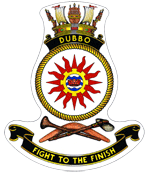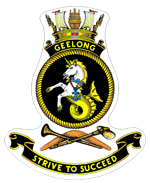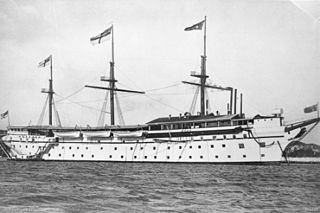
The Fremantle-class patrol boats were coastal patrol vessels operated by the Royal Australian Navy (RAN) from 1979 to 2007. Designed by British shipbuilder Brooke Marine and constructed in Australia by NQEA, the Fremantle class were larger, more powerful, and more capable than the preceding Attack class, and the two primary patrol boat bases required infrastructure upgrades to support them. Although up to 30 vessels were planned, fifteen were ordered and constructed, with an unexercised option for five more.

The Hobart class is a ship class of three air warfare destroyers (AWDs) built for the Royal Australian Navy (RAN). Planning for ships to replace the Adelaide-class frigates and restore the capability last exhibited by the Perth-class destroyers began by 2000, initially under acquisition project SEA 1400, which was re-designated SEA 4000. Although the designation "Air Warfare Destroyer" is used to describe ships dedicated to the defence of a naval force from aircraft and missile attack, the destroyers are expected to also operate in anti-surface, anti-submarine, and naval gunfire support roles.

The Cockatoo Island Dockyard was a major dockyard in Sydney, Australia, based on Cockatoo Island. The dockyard was established in 1857 to maintain Royal Navy warships. It later built and repaired military and battle ships, and played a key role in sustaining the Royal Australian Navy. The dockyard was closed in 1991, and its remnants are heritage listed as the Cockatoo Island Industrial Conservation Area.
The Royal Australian Navy, although a significant force in the Asia-Pacific region, is nonetheless classed as a medium-sized navy. Its fleet is based around two main types of surface combatant, with limited global deployment and air power capability. However, in 2009, a white paper, Defending Australia in the Asia Pacific Century: Force 2030, was produced by the Australian government which set out a programme of defence spending that will see significant improvements to the RAN's fleet and capabilities.

HMAS Vendetta (D69/I69) was a V-class destroyer that served in the Royal Navy and the Royal Australian Navy (RAN). One of 25 V class ships ordered for the Royal Navy during World War I, Vendetta entered service in 1917.
BAE Systems Australia, a subsidiary of BAE Systems plc, is one of the largest defence contractors in Australia. It was formed by the merger of British Aerospace Australia and GEC-Marconi Systems and expanded by the acquisitions of Armor Holdings in 2007 and Tenix Defence in June 2008.

The Leeuwin class is a two-ship class of hydrographic survey vessels operated by the Royal Australian Navy (RAN). Leeuwin and Melville were ordered from NQEA Australia in 1996, and were commissioned in 2000. The ships are capable of charting waters up to 6,000 metres (20,000 ft) deep, carry three Fantome-class survey boats, and could operate an AS 350B Squirrel helicopter. In addition to surveying duties, since 2001 both vessels have been used to supplement the RAN patrol force. Leeuwin and Melville are based at HMAS Cairns, and are active as of 2023.

HMAS Dubbo, named for the city of Dubbo, New South Wales, was a Fremantle-class patrol boat of the Royal Australian Navy (RAN).

HMAS Ipswich, named for the city of Ipswich, Queensland, was a Fremantle-class patrol boat in the Royal Australian Navy (RAN).

HMAS Melville is the second ship of the Leeuwin class of hydrographic survey vessels operated by the Royal Australian Navy (RAN).
HMAS Whyalla, named for the city of Whyalla, South Australia, was a Fremantle-class patrol boat of the Royal Australian Navy (RAN).

HMAS Gawler, named for the town of Gawler, South Australia was a Fremantle-class patrol boat of the Royal Australian Navy (RAN).

HMAS Gladstone, named for the city of Gladstone, Queensland, is a Fremantle-class patrol boat, formerly of the Royal Australian Navy (RAN). Built by NQEA during the early 1980s, Gladstone was commissioned into RAN service in 1984.

HMAS Geraldton, named for the port city of Geraldton, Western Australia, was a Fremantle-class patrol boat of the Royal Australian Navy (RAN).

HMAS Geelong, named for the city of Geelong, was a Fremantle-class patrol boat of the Royal Australian Navy (RAN).

HMAS Tingira was a training ship operated by the Royal Australian Navy (RAN) between 1911 and 1927. Alexander Hall & Co. built the ship in Scotland in 1866 as the passenger clipper Sobraon; she was the largest composite-hull sailing vessel ever built. She sailed on an annual migration run between England and Australia until 1891, when she was sold to the colonial government of New South Wales for use as a reformatory ship. The vessel was then sold to the federal government in 1911, and entered RAN service. Tingira was paid off in 1927, but despite efforts to preserve the ship, was broken up in 1941.

Forgacs Shipyard is a shipbuilding company located at Tomago, New South Wales on the Hunter River. It was originally opened in 1957 by John Laverick at Carrington as Carrington Slipways, and built 45 ships between then and 1968. By 1972, the business required larger premises and moved to Tomago, not far from the Pacific Highway. The shipyard was purchased by Forgacs Engineering in 1997.
The Cockatoo Docks & Engineering Company was a ship building and maintenance company which operated the Cockatoo Island Dockyard on Cockatoo Island in Sydney, Australia, between 1933 and 1992.
















